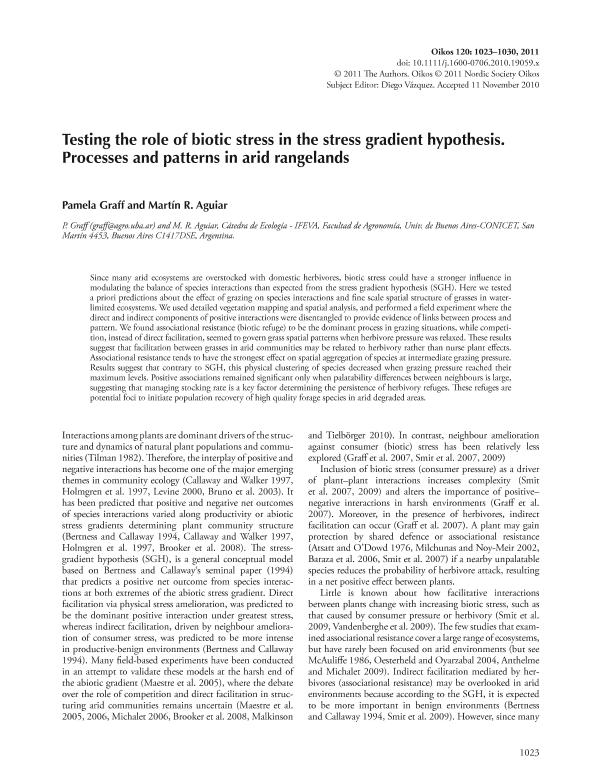Mostrar el registro sencillo del ítem
dc.contributor.author
Graff, Barbara Pamela

dc.contributor.author
Aguiar, Martin Roberto

dc.date.available
2020-02-10T19:32:50Z
dc.date.issued
2011-06
dc.identifier.citation
Graff, Barbara Pamela; Aguiar, Martin Roberto; Testing the role of biotic stress in the stress gradient hypothesis. Processes and patterns in arid rangelands; Wiley Blackwell Publishing, Inc; Oikos; 120; 7; 6-2011; 1023-1030
dc.identifier.issn
0030-1299
dc.identifier.uri
http://hdl.handle.net/11336/97096
dc.description.abstract
Since many arid ecosystems are overstocked with domestic herbivores, biotic stress could have a stronger influence in modulating the balance of species interactions than expected from the stress gradient hypothesis (SGH). Here we tested a priori predictions about the effect of grazing on species interactions and fine scale spatial structure of grasses in water‐limited ecosystems. We used detailed vegetation mapping and spatial analysis, and performed a field experiment where the direct and indirect components of positive interactions were disentangled to provide evidence of links between process and pattern. We found associational resistance (biotic refuge) to be the dominant process in grazing situations, while competition, instead of direct facilitation, seemed to govern grass spatial patterns when herbivore pressure was relaxed. These results suggest that facilitation between grasses in arid communities may be related to herbivory rather than nurse plant effects. Associational resistance tends to have the strongest effect on spatial aggregation of species at intermediate grazing pressure. Results suggest that contrary to SGH, this physical clustering of species decreased when grazing pressure reached their maximum levels. Positive associations remained significant only when palatability differences between neighbours is large, suggesting that managing stocking rate is a key factor determining the persistence of herbivory refuges. These refuges are potential foci to initiate population recovery of high quality forage species in arid degraded areas.
dc.format
application/pdf
dc.language.iso
eng
dc.publisher
Wiley Blackwell Publishing, Inc

dc.rights
info:eu-repo/semantics/openAccess
dc.rights.uri
https://creativecommons.org/licenses/by-nc-sa/2.5/ar/
dc.subject
BIOTIC GRADIENT
dc.subject
BROMUS PICTUS
dc.subject
COMPETITION
dc.subject
FACILITATION
dc.subject
HERBIVORY REFUGES
dc.subject
POA LIGULARIS
dc.subject
SPATIAL PATTERN ANALYSIS
dc.subject
STIPA SPECIOSA
dc.subject
STRESS AMELIORATION
dc.subject
PATAGONIAN STEPPE
dc.subject.classification
Ecología

dc.subject.classification
Ciencias Biológicas

dc.subject.classification
CIENCIAS NATURALES Y EXACTAS

dc.title
Testing the role of biotic stress in the stress gradient hypothesis. Processes and patterns in arid rangelands
dc.type
info:eu-repo/semantics/article
dc.type
info:ar-repo/semantics/artículo
dc.type
info:eu-repo/semantics/publishedVersion
dc.date.updated
2020-02-07T13:49:04Z
dc.journal.volume
120
dc.journal.number
7
dc.journal.pagination
1023-1030
dc.journal.pais
Reino Unido

dc.journal.ciudad
Londres
dc.description.fil
Fil: Graff, Barbara Pamela. Consejo Nacional de Investigaciones Científicas y Técnicas. Oficina de Coordinación Administrativa Parque Centenario. Instituto de Investigaciones Fisiológicas y Ecológicas Vinculadas a la Agricultura. Universidad de Buenos Aires. Facultad de Agronomía. Instituto de Investigaciones Fisiológicas y Ecológicas Vinculadas a la Agricultura; Argentina
dc.description.fil
Fil: Aguiar, Martin Roberto. Consejo Nacional de Investigaciones Científicas y Técnicas. Oficina de Coordinación Administrativa Parque Centenario. Instituto de Investigaciones Fisiológicas y Ecológicas Vinculadas a la Agricultura. Universidad de Buenos Aires. Facultad de Agronomía. Instituto de Investigaciones Fisiológicas y Ecológicas Vinculadas a la Agricultura; Argentina
dc.journal.title
Oikos

dc.relation.alternativeid
info:eu-repo/semantics/altIdentifier/url/https://onlinelibrary.wiley.com/doi/abs/10.1111/j.1600-0706.2010.19059.x
dc.relation.alternativeid
info:eu-repo/semantics/altIdentifier/doi/https://doi.org/10.1111/j.1600-0706.2010.19059.x
Archivos asociados
